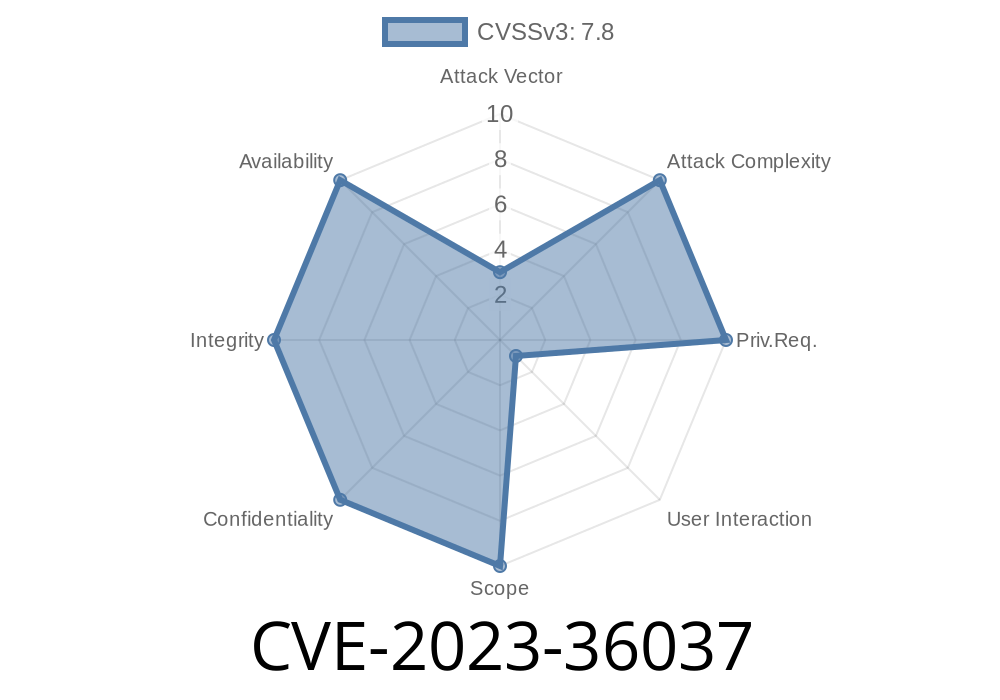With the increasing number of cyber threats worldwide, safeguarding communication and data has become more critical than ever. Recently, a new vulnerability has surfaced in Microsoft Excel, identified as CVE-2023-36037. This vulnerability revolves around a security feature bypass that allows an attacker to execute arbitrary code on the victim's system. In this in-depth article, we will dissect CVE-2023-36037, break down the potential risks and exploits, and recommend countermeasures and best practices to prevent compromise.
CVE Details
ID: CVE-2023-36037
Title: Microsoft Excel Security Feature Bypass Vulnerability
Description: This vulnerability exists in Microsoft Excel due to improper handling of certain files, which potentially allows an attacker to bypass security features, ultimately executing arbitrary code on the targeted system.
Affected Software and Versions: Microsoft Excel
Original References
Microsoft Advisory for CVE-2023-36037
Common Vulnerabilities and Exposures (CVE) Details
Analysing the Vulnerability
The vulnerability in question affects Microsoft Excel due to improper management of specific file types. It ultimately permits the attacker to bypass security features, potentially executing arbitrary code on the victim's machine.
The entry point is typically a specially crafted file, designed to trigger the vulnerability when opened by the target. Because the security restrictions within Excel are inadequately enforced for these files, the attacker can embed executable code that would otherwise be blocked.
Here is a code snippet that demonstrates the vulnerability using a macro-enabled Excel file
Sub Bypass_Security_Feature()
Dim objShell As Object
Set objShell = CreateObject("Wscript.Shell")
Dim cmd As String
' This is a simple example of arbitrary code execution:
cmd = "calc.exe"
objShell.Run cmd, , True
End Sub
While this example simply triggers the Windows calculator application, it showcases how the attacker could potentially run any code on the victim's machine without proper security measures in place.
Understanding Exploits
Once the attacker successfully bypasses Microsoft Excel's security features, they can exploit this vulnerability in several ways, including:
Stealing sensitive information stored on the target machine.
2. Installing malware or ransomware, encrypting the victim's files until released by the attacker (often for a monetary ransom).
3. Utilizing the compromised system as an access point to penetrate deeper into the victim's network or launch further attacks against other targets.
To mitigate potential threats associated with CVE-2023-36037, several precautions should be taken
1. Update Microsoft Excel to the latest version, as it may contain patches that address this vulnerability. Keep an eye out for security advisories and follow Microsoft's recommendations, such as in the official security guidance.
2. Implement strict security policies that restrict the opening of macro-enabled and potentially malicious files. Verify the source of any files received and scrutinize any unwanted or unexpected emails with attachments.
3. Educate users about the dangers of phishing emails and potential social engineering scams. It is crucial to maintain a strong security culture within your organization.
4. Keep your antivirus software updated and perform regular system scans to detect and block any unwanted intrusions.
5. Have a strong incident response plan in place, enabling your organization to act quickly in the event of a compromise or attempted attack.
Conclusion
CVE-2023-36037 is a serious threat that allows attackers to bypass security features in Microsoft Excel, ultimately executing arbitrary code on a target machine. This vulnerability underscores the importance of understanding the risks associated with unpatched software and unsafe file-handling practices. By employing the countermeasures and best practices outlined in this article, you can protect your organization from this vulnerability and safeguard your sensitive data.
Timeline
Published on: 11/14/2023 18:15:33 UTC
Last modified on: 11/20/2023 19:52:54 UTC
